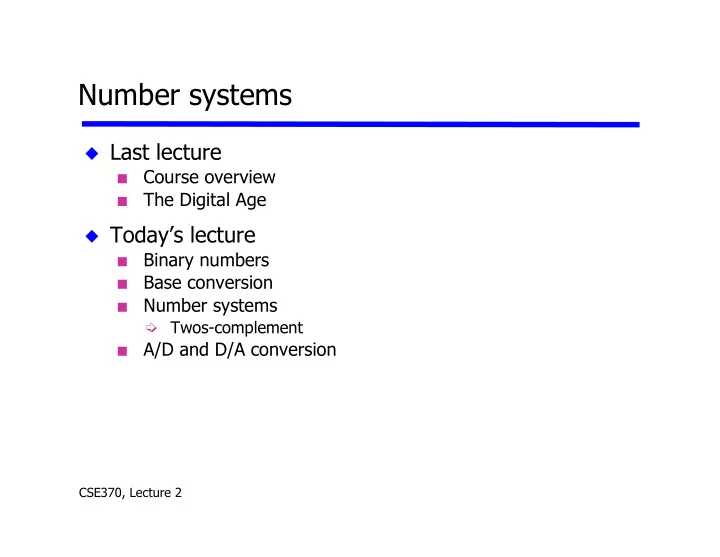

Number systems Last lecture Course overview The Digital Age Today’s lecture Binary numbers Base conversion Number systems Twos-complement A/D and D/A conversion CSE370, Lecture 2
Digital Digital = discrete Decimal BCD Binary codes (example: BCD) Symbols Code Decimal digits 0-9 0 0000 DNA nucleotides 1 0001 2 0010 Binary codes 3 0011 Represent symbols using binary 4 0100 digits (bits) 5 0101 6 0110 Digital computers: 7 0111 I/O is digital 8 1000 ASCII, decimal, etc. 9 1001 Internal representation is binary Process information in bits CSE370, Lecture 2
The basics: Binary numbers Bases we will use Binary: Base 2 Octal: Base 8 Hexadecimal: Base 16 Positional number system 101 2 = 1 × 2 2 + 0 × 2 1 + 1 × 2 0 63 8 = A1 16 = Addition and subtraction 1011 1011 + 1010 – 0110 CSE370, Lecture 2
Binary → hex/decimal/octal conversion Conversion from binary to octal/hex Binary: 10011110001 Octal: Hex: Conversion from binary to decimal 101 2 = 1 × 2 2 + 0 × 2 1 + 1 × 2 0 = 5 10 63.4 8 = A1 16 = CSE370, Lecture 2
Decimal → binary/octal/hex conversion Why does this work? N=56 10 =111000 2 Q=N/2=56/2=111000/2=11100 remainder 0 Each successive divide liberates an LSB CSE370, Lecture 2
Number systems How do we write negative binary numbers? Historically: 3 approaches Sign-and-magnitude Ones-complement Twos-complement For all 3, the most-significant bit (msb) is the sign digit 0 ≡ positive 1 ≡ negative Learn twos-complement Simplifies arithmetic Used almost universally CSE370, Lecture 2
Sign-and-magnitude The most-significant bit (msb) is the sign digit 0 ≡ positive 1 ≡ negative The remaining bits are the number’s magnitude Problem 1: Two representations for zero 0 = 0000 and also –0 = 1000 Problem 2: Arithmetic is cumbersome CSE370, Lecture 2
Ones-complement Negative number: Bitwise complement positive number 0011 ≡ 3 10 1100 ≡ –3 10 Solves the arithmetic problem Remaining problem: Two representations for zero 0 = 0000 and also –0 = 1111 CSE370, Lecture 2
Twos-complement Negative number: Bitwise complement plus one 0011 ≡ 3 10 1101 ≡ –3 10 – 1 0 Number wheel – 2 + 1 1111 0000 1110 0001 – 3 + 2 Only one zero! 1101 0010 – 4 + 3 1100 0011 msb is the sign digit 1011 0100 0 ≡ positive – 5 + 4 1010 0101 1 ≡ negative – 6 + 5 1001 0110 1000 0111 – 7 + 6 – 8 + 7 CSE370, Lecture 2
Twos-complement (con’t) Complementing a complement the original number Arithmetic is easy Subtraction = negation and addition Easy to implement in hardware CSE370, Lecture 2
Miscellaneous Twos-complement of non-integers 1.6875 10 = 01.1011 2 –1.6875 10 = 10.0101 2 Sign extension Write +6 and –6 as twos complement 0110 and 1010 Sign extend to 8-bit bytes 00000110 and 11111010 Can’t infer a representation from a number 11001 is 25 (unsigned) 11001 is –9 (sign magnitude) 11001 is –6 (ones complement) 11001 is –7 (twos complement) CSE370, Lecture 2
Twos-complement overflow Summing two positive numbers gives a negative result Summing two negative numbers gives a positive result – 1 0 – 1 0 – 2 + 1 – 2 + 1 1111 0000 1111 0000 1110 0001 1110 0001 – 3 + 2 – 3 + 2 1101 0010 1101 0010 – 4 + 3 – 4 + 3 1100 0011 1100 0011 1011 0100 1011 0100 – 5 + 4 – 5 + 4 1010 0101 1010 0101 – 6 + 5 – 6 + 5 1001 0110 1001 0110 1000 0111 1000 0111 + 6 + 6 – 7 – 7 – 8 + 7 – 8 + 7 6 + 4 ⇒ –6 –7 – 3 ⇒ +6 CSE370, Lecture 2
Twos-complement overflow (cont’d) 1111 –1 0011 +3 Correct results + 1010 –6 + 0010 +2 1 1001 –7 0101 +5 Incorrect results 0110 +6 1001 –7 + 0100 +4 + 1010 –6 1010 –6 1 0011 +3 Overflow condition Carry from 2sb-msb 2sb-msb msb-Cout Overflow and carry from msb- 0 0 0 Cout are different 0 1 1 1 0 1 1 1 0 CSE370, Lecture 2
Gray and BCD codes Decimal Gray Decimal BCD Symbols Code Symbols Code 0 0000 0 0000 1 0001 1 0001 2 0011 2 0010 3 0010 3 0011 4 0110 4 0100 5 0111 5 0101 6 0101 6 0110 7 0100 7 0111 8 1100 8 1000 9 1101 9 1001 CSE370, Lecture 2
The physical world is analog Digital systems need to Measure analog quantities Speech waveforms, etc Control analog systems Drive motors, etc How do we connect the analog and digital domains? Analog-to-digital converter (ADC or A/D) Example: CD recording Digital-to-analog converter (DAC or D/A) Example: CD playback CSE370, Lecture 2
Sampling Quantization Conversion from analog to discrete values Quantizing a signal We sample it Datel Data Acquisition and Conversion Handbook CSE370, Lecture 2
Conversion Encoding Assigning a digital word to each discrete value Encoding a quantized signal Encode the samples Typically Gray or binary codes Datel Data Acquisition and Conversion Handbook CSE370, Lecture 2
Recommend
More recommend